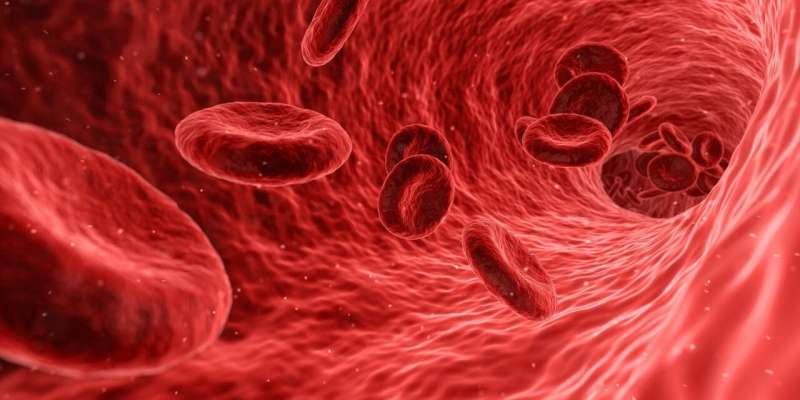by Perelman School of Medicine at the University of Pennsylvania

Credit: CC0 Public Domain
New research has uncovered a precision medicine test using blood proteins to identify a novel patient subgroup of idiopathic multicentric Castleman disease (iMCD), a rare blood disorder, who are more likely to respond to siltuximab, the only FDA approved treatment for the disease. The international study was led by researchers at Penn Medicine and the Castleman Disease Collaborative Network (CDCN).
Prior research suggests that half of patients do not respond to the monoclonal antibody treatment, siltuximab. For those patients, rapid administration of other treatments is needed to prevent deterioration, so understanding who is likely to benefit is critical. This study also revealed that an existing drug approach, Janus kinase (JAK) inhibitors, which are already approved for treating certain cancers and rheumatoid arthritis, are a promising alternative treatment option for patients who do not respond to siltuximab. The study, which is the largest to date for iMCD, is published in Blood Advances.
“This discovery has the potential to improve precision medicine for iMCD—the concept that the right patient is given the right drug at the right time. Knowing which patients are likely to benefit from which drugs is a key piece of this puzzle,” said David Fajgenbaum, MD, MBA, MSc, an assistant professor of Translational Medicine and Human Genetics, Director of the Center for Cytokine Storm Treatment & Laboratory at the Perelman School of Medicine at the University of Pennsylvania, co-founder of the CDCN, and associate director of patient impact at the Penn Orphan Disease Center, and the study’s senior author. Fajgenbaum is also an iMCD patient.
Castleman disease isn’t actually a single disease. The term describes a group of inflammatory disorders and is diagnosed in about 5,000 people of all ages each year in the United States, which makes it roughly as common as Amyotrophic Lateral Sclerosis (ALS). Patients experience a range of symptoms—from a single enlarged lymph node with mild flu-like symptoms (unicentric) to enlarged lymph nodes located throughout their body, abnormal blood cell counts, and life-threatening failure of multiple organ systems (multicentric). The most severe subtype is iMCD, which has similarities to autoimmune conditions and cancer, and involves a cytokine storm. A cytokine storm describes what happens when the immune system goes into overdrive as can be seen in severe COVID-19 and a number of other conditions. About 35 percent of patients with iMCD will die within five years of diagnosis.
Studies have shown that siltuximab can send between one-third and one-half of patients into a remission that generally lasts for years. However, patients who are in the ICU and don’t respond to siltuximab have few options and limited time. They typically receive chemotherapy, but often relapse, meaning many iMCD patients endure months without appropriate treatment. It took more than 11 weeks for Fajgenbaum to be correctly diagnosed, during which time he experienced two life-threatening episodes of the disease, did not respond to siltuximab, and had to be treated with rapid chemotherapy.
For this study, researchers examined blood samples from 88 iMCD patients and measured 1,178 blood proteins in each of those samples, identifying seven blood proteins that were able to effectively predict the subgroup of patients who were most likely to respond to siltuximab. The results were subsequently validated in an independent cohort of 23 iMCD patients.
“Had this test been available for me, I would have likely gotten second-line treatment more rapidly, lowering my risk of death while I was waiting to see if first-line treatment would work. But just as importantly, this study also identifies another potential treatment to be included in our arsenal,” Fajgenbaum said.
Previous research has shown that in many cases the cytokine storm in iMCD is tied to a cytokine, or inflammatory mediator, called interleukin-6 (IL-6), which in turn is connected to another pathway called mTOR, opening a new treatment possibility with mTOR inhibitors. Fajgenbaum discovered mTOR inhibitors as the first novel treatment for iMCD in 25 years and began taking an mTOR inhibitor himself, called sirolimus. This study advanced these findings further and found that another pathway called JAK seems to be a critical mediator of the cytokine storm, with JAK inhibitors like ruxolitinib and baricitinib potentially providing relief.
“These aren’t findings that require decades of study before they can benefit patients. These drugs can potentially be used right away to help iMCD patients with no other options because they are already approved by the FDA for other diseases. We are basically searching for and finding solutions that are hiding in plain sight,” said Sheila Pierson, MS, Director of Registry Enrollment for the CDCN as well as the Associate Director for Clinical Research for the Center for Cytokine Storm Treatment at the University of Pennsylvania, and the study’s first author.
In fact, in an article published in The Lancet in May 2021, Fajgenbaum and co-authors described a patient diagnosed with iMCD, who was given and responded to a combination of therapies, including baricitinib, based on the findings this study provided. While the patient was deteriorating until the baricitinib was added and there was a notable improvement afterward, more work is needed to investigate the role of this treatment for iMCD and to improve the clinical applicability of the precision medicine test.

Leave a Reply